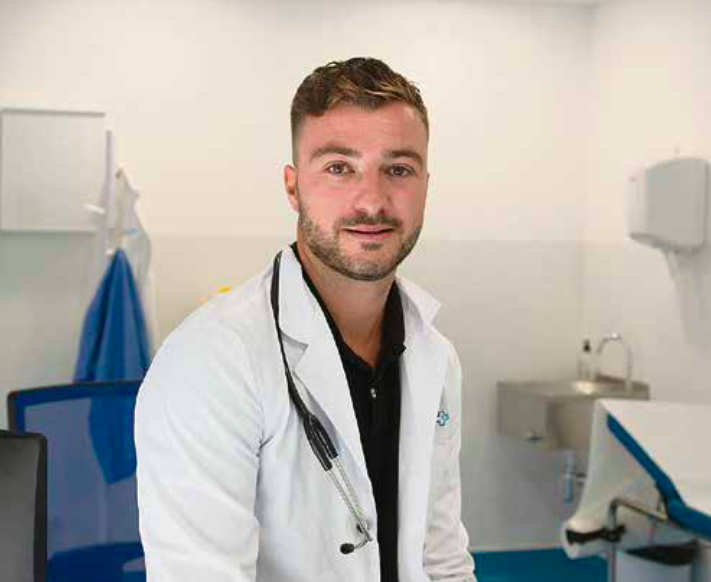

AZIOPTIK ROMFARM

Ask a doctor about a prescription for AZIOPTIK ROMFARM

How to use AZIOPTIK ROMFARM
INSTRUCTIONS for medical use of the medicinal product THIO CETAM FORTE (THIOCETAM FORTE)
Composition:
active substances: 1 tablet contains: piracetam in terms of 100% substance - 400 mg; morpholine salt of thiazolone acid in terms of 100% substance, equivalent to 66.5 mg of thiazolone acid - 100 mg;
excipients: potato starch; mannitol; powdered sugar; magnesium stearate; povidone; coating mixture **.
** - the coating mixture contains: hypromellose; lactose monohydrate; titanium dioxide (E 171); polyethylene glycol / macrogol; triacetin.
Pharmaceutical form.
Tablets, film-coated.
Main physical and chemical properties:
film-coated tablets of white or almost white color, oval shape, with a notch on one side of the tablet.
Pharmacotherapeutic group.
Psychostimulants and nootropics.
ATC code N06B X.
Pharmacological properties.
Pharmacodynamics.
The preparation belongs to the group of cerebroactive agents, has anti-ischemic, antioxidant, membrane-stabilizing and nootropic properties.
The preparation improves the integrative and cognitive activity of the brain, increases the effectiveness of the learning process, helps to eliminate symptoms of amnesia, improves indicators of short-term and long-term memory.
The pharmacological effect of the preparation is due to the synergistic action of thiazolone acid and piracetam.
The preparation is able to accelerate the oxidation of glucose in aerobic and anaerobic oxidation reactions, normalize bioenergetic processes, increase the level of ATP, stabilize metabolism in brain tissues.
The preparation inhibits the formation of active oxygen species, reactivates the antioxidant enzyme system, especially superoxide dismutase, inhibits free radical processes in brain tissues during ischemia, improves the rheological properties of blood due to the activation of the fibrinolytic system, stabilizes and reduces the areas of necrosis and ischemia.
Pharmacokinetics.
Well absorbed when taken orally, penetrates into various organs and tissues, including brain tissues. The preparation penetrates the placental barrier. Each component of the preparation is metabolized separately. Piracetam is practically not metabolized in the body and is excreted in the urine. The half-life is 4-8 hours. Morpholine salt of thiazolone acid after oral administration is quickly absorbed, its absolute bioavailability is 53%. The maximum concentration in plasma is reached 1.6 hours after a single dose of 200 mg. The half-life is approximately 8 hours.
Clinical characteristics.
Indications.
Transient and chronic disorders of cerebral circulation, caused by atherosclerosis of the cerebral vessels and disorders of cerebral circulation in the past. The preparation is also indicated for disorders of cerebral circulation, disorders of brain metabolism, caused by craniocerebral trauma, intoxications, diabetic encephalopathy, as well as in the rehabilitation period after ischemic stroke.
Contraindications.
Increased sensitivity to piracetam or pyrrolidone derivatives, and/or to thiazolone acid, as well as to any other component of the preparation.
Acute violation of cerebral circulation of the hemorrhagic type.
Acute renal failure. Terminal stage of renal failure.
Huntington's chorea.
Interaction with other medicinal products and other types of interactions.
Thio cetam® Forte should not be prescribed with preparations that have an acidic pH.
Due to the presence of piracetam in the composition, the following types of interactions are possible
Thyroid hormones.
When used in combination with thyroid hormones (T3 + T4), increased irritability, disorientation, and sleep disturbances are possible.
Acenocoumarol.
In patients with severe recurrent thrombosis, the use of piracetam in high doses (9.6 g/day) did not affect the dosing of acenocoumarol to achieve a prothrombin time (INR) of 2.5-3.5, but with its simultaneous use, a significant decrease in platelet aggregation, fibrinogen, and factors VIII was noted: C; VIII: vW: Ag; VIII: vW: Rco), blood viscosity, and plasma.
Pharmacokinetic interactions.
The likelihood of changing the pharmacodynamics of piracetam under the influence of other medicinal products is low, since 90% of the preparation is excreted in unchanged form with urine.
In vitro, piracetam does not inhibit cytochrome P450 isoforms CYP1A2, 2B6, 2C8, 2C9, 2C19, 2D6, 2E1, and 4A9/11 at a concentration of 142, 426, 1422 μg/ml.
At a concentration of 1422 μg/ml, a slight inhibition of CYP2A6 (21%) and 3A4/5 (11%) was noted. However, the level of Ki of these two CYP isoforms is sufficient when exceeding 1422 μg/ml. Therefore, metabolic interaction with preparations that undergo biotransformation by these enzymes is unlikely.
Antiepileptic medicinal products.
The use of piracetam in a dose of 20 mg/day daily for 4 weeks or more did not change the curve of the concentration level and the maximum concentration (Cmax) of antiepileptic preparations in the blood serum (carbamazepine, phenytoin, phenobarbital, sodium valproate) in patients with epilepsy.
Concomitant administration with enalapril, captopril increases the risk of developing side reactions from the cardiovascular system.
Alcohol.
Concomitant administration with alcohol did not affect the level of piracetam concentration in blood serum, and the concentration of alcohol in blood serum did not change when using 1.6 g of piracetam.
Features of application.
The preparation should be taken with caution by elderly patients who suffer from cardiovascular pathology, as side reactions in this group of patients are more frequent.
Allergic reactions occur more frequently in individuals prone to allergies.
Influence on platelet aggregation.
Since piracetam reduces platelet aggregation, the preparation should be prescribed with caution to patients with impaired hemostasis, conditions that may be accompanied by bleeding (gastrointestinal tract ulcer), during significant surgical interventions (including dental procedures), patients with symptoms of severe bleeding or patients who have a history of hemorrhagic stroke; patients who use anticoagulants, platelet anti-aggregants, including low doses of acetylsalicylic acid. The preparation is excreted by the kidneys, so special attention should be paid to patients with renal failure.
Elderly patients.
During long-term therapy in elderly patients, regular monitoring of kidney function indicators is recommended, and if necessary, the dose should be adjusted depending on the results of the creatinine clearance study.
The preparation contains lactose as an excipient, which should be taken into account by patients with galactose intolerance, lactase deficiency, or impaired glucose/galactose absorption.
1 tablet of Thio cetam® Forte contains 0.007 g of powdered sugar, which should be taken into account by patients with diabetes.
Use during pregnancy or breastfeeding.
Should not be used.
Ability to affect reaction speed when driving vehicles or other mechanisms.
It is not recommended to use the preparation when driving vehicles and working with mechanisms that require increased attention, due to the risk of developing possible undesirable reactions from the nervous system.
Method of application and doses.
The dosage and duration of treatment are determined by the doctor in each individual case, depending on the nature and course of the disease.
For transient and chronic disorders of cerebral circulation and in the rehabilitation period after ischemic stroke, 1 tablet 3 times a day for 25-30 days.
Thio cetam® Forte tablets should be taken 30 minutes before meals.
The course of treatment is from 2-3 weeks to 3-4 months.
For the treatment of diabetic encephalopathy, 1 tablet 3 times a day for 45 days.
Children.
Should not be used.
Overdose.
When using therapeutic doses, overdose is impossible.
When deviating from the doses prescribed by the doctor, the occurrence and intensification of side effects of the preparation (excitement, sleep disturbances, dyspeptic phenomena) are possible. In these cases, the dose of the preparation should be reduced, and symptomatic treatment should be prescribed (induction of vomiting, gastric lavage).
In case of overdose, the concentration of sodium and potassium in the urine increases. In such cases, the preparation should be canceled.
Side reactions.
During the clinical use of the Thio cetam® Forte preparation, cases of side reactions may be observed:
from the central and peripheral nervous system: headache, general weakness, insomnia, drowsiness, anxiety, internal tension;
from the gastrointestinal tract: nausea, vomiting, dryness in the mouth, diarrhea;
from the immune system, skin, and subcutaneous tissue: allergic reactions, including rash, itching, urticaria, sweating;
from the vestibular system: dizziness.
Possible development of side reactions caused by individual components of the preparation:
- piracetam:
from the blood and lymphatic system: hemorrhagic disorders;
from the immune system: hypersensitivity, anaphylactoid reactions;
mental disorders: nervousness, depression, increased excitability, anxiety, confusion, hallucinations;
from the nervous system: hyperkinesia, drowsiness, ataxia, balance disorders, increased frequency of epileptic seizures, headache, insomnia, tremor;
from the organs of hearing and labyrinth: dizziness;
from the digestive system: abdominal pain, pain in the upper abdomen, diarrhea, nausea, vomiting;
from the skin and subcutaneous tissue: angioedema, dermatitis, rash, urticaria, itching;
from the reproductive system and breastfeeding: increased sexual activity;
general disorders: asthenia, weight gain.
- thiazolone acid:
from the skin and subcutaneous tissue: itching, hyperemia of the skin, rash, urticaria, angioedema;
from the immune system: anaphylactic shock;
from the central and peripheral nervous system: dizziness, tinnitus;
from the cardiovascular system: tachycardia, increased blood pressure;
from the gastrointestinal tract: dyspepsia, including dryness in the mouth, bloating, nausea, vomiting;
from the respiratory system: shortness of breath, dyspnea;
general disorders: fever, general weakness.
Shelf life.
3 years.
Storage conditions.
In the original packaging at a temperature not exceeding 25 °C. Store in a place inaccessible to children.
Packaging.
10 tablets in a blister pack, 3 or 6 blister packs in a carton.
Release category.
By prescription.
Manufacturer.
JSC "Kyivmedpreparat).
Location of the manufacturer and its address.
Ukraine, 01032, Kyiv, Saksaganskogo street, 139.
- Country of registration
- Active substance
- Prescription requiredYes
- Manufacturer
- This information is for reference only and does not constitute medical advice. Always consult a licensed doctor before taking any medication. Oladoctor is not responsible for medical decisions based on this content.
- Alternatives to AZIOPTIK ROMFARMDosage form: drops, 15 mg/g, 250 mg per single-dose containerActive substance: azithromycinManufacturer: ЛАБОРАТУАР ЮНІТЕРPrescription requiredDosage form: drops, 0.25% 10mlActive substance: chloramphenicolManufacturer: ТОВ "ФЗ "БІОФАРМАPrescription requiredDosage form: drops, 0.25 %; 10 ml in vialsActive substance: chloramphenicolManufacturer: ПРАТ "ФІТОФАРМPrescription required
Alternatives to AZIOPTIK ROMFARM in other countries
The best alternatives with the same active ingredient and therapeutic effect.
Alternative to AZIOPTIK ROMFARM in Poland
Alternative to AZIOPTIK ROMFARM in Spain
Online doctors for AZIOPTIK ROMFARM
Discuss dosage, side effects, interactions, contraindications, and prescription renewal for AZIOPTIK ROMFARM – subject to medical assessment and local rules.














